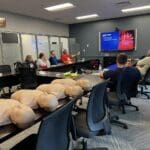Stay Cool and Safe This Summer: Guite to Heat Emergencies – Heat Cramps, Heat Exhaustion, and Heat Stroke Guide
Summer is here! But the sun can sometimes be a sneaky prankster. Heat cramps, heat exhaustion, and heat stroke are the uninvited party crashers. Don’t worry, though! With some simple tips, you can keep these heat villains at bay. Let’s explore the causes, prevention, and first aid for these heat-related conditions. We’ll even keep it light-hearted—pun intended!
The Culprits: Causes of Heat Cramps, Heat Exhaustion, and Heat Stroke
What cranks up the heat on these conditions?
- Heat Cramps: This is the first sign your body needs a break. Painful muscle spasms happen when you sweat too much and lose electrolytes. It’s your body’s way of saying, “Time out, please!”
- Heat Exhaustion: The next level up. Your body struggles to cool down. Symptoms like heavy sweating, weakness, dizziness, and nausea kick in. It’s like your internal AC is on the fritz.
- Heat Stroke: This one’s the heavyweight. It’s a life-threatening condition where your body’s temperature soars above 104°F (40°C). Symptoms include confusion, loss of consciousness, and even seizures. It’s your body in full meltdown mode.
Prevention: How to Keep Your Cool
Want to stay cool as a cucumber? Here’s how:
- Hydrate Like a Boss: Drink lots of water, even if you’re not thirsty. Think of it as keeping your internal radiator topped off.
- Dress Smart: Wear light-colored, loose-fitting clothes. They help your body breathe and reflect the sun’s rays.
- Take Breaks: Don’t try to be a hero. Rest in the shade or indoors. Your body will thank you.
- Avoid Peak Heat: Stay inside between 10 a.m. and 4 p.m. when the sun’s at its fiercest. It’s like dodging rush hour but with UV rays.
- Eat Light: Heavy meals can heat you up. Opt for salads, fruit, and lighter fare. It’s like turning down a roaring fire to a gentle simmer.
First Aid: What to Do When Heat Strikes
Spotting signs of a heat emergency? Time to act fast!
For Heat Cramps:
- Hydrate: Drink water or a sports drink to restore electrolytes.
- Rest: Find a cool spot to sit down.
- Stretch: Gently massage and stretch the affected muscles.
For Heat Exhaustion:
- Cool Down: Move to a cooler area.
- Hydrate: Drink water or sports drinks.
- Rest: Lie down and elevate your legs.
- Cool Compresses: Apply cool, wet cloths to the skin.
For Heat Stroke:
- Call 911: This is an emergency.
- Cool the Person: Move them to a cooler spot and use cool cloths or ice packs on the neck, armpits, and groin.
- Hydrate (if conscious): Offer sips of water, but not too much at once.
FAQs: Your Burning Questions Answered About Heat Emergencies
- Q: Can you get heat cramps, heat exhaustion, and heat stroke indoors?
A: Yes! A hot, poorly ventilated room can cause these conditions. Ensure good airflow and stay hydrated. - Q: How quickly can heat stroke develop?
A: It can develop fast, sometimes within 10 to 15 minutes. Act quickly if you see the signs. - Q: Are some people more at risk for heat-related illnesses?
A: Yes. Infants, kids, the elderly, and those with chronic illnesses or on certain medications are more vulnerable. Keep an extra eye on them. - Q: Can drinking water alone prevent heat stroke?
A: Staying hydrated helps, but it’s not enough. Avoid excessive heat exposure, wear the right clothes, and take breaks in cool spots. - Q: Is it safe to exercise in hot weather?
A: Yes, with precautions. Drink plenty of water, wear light clothes, and avoid peak sun hours. Listen to your body, and stop if you feel unwell.
Conclusion: Keep Cool and Carry On
Summer can be a blast if you plan ahead and stay aware. Hydrate, dress smart, and pay attention to your body’s signals. Also remember, knowing the right first aid steps can make all the difference when things get too hot to handle. Stay cool, everyone! 🌞





